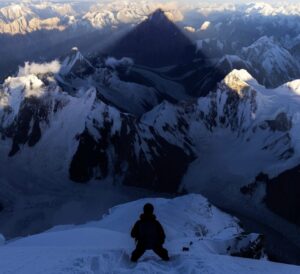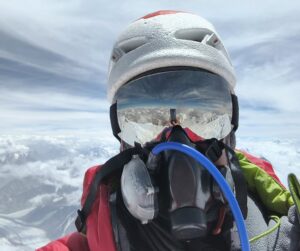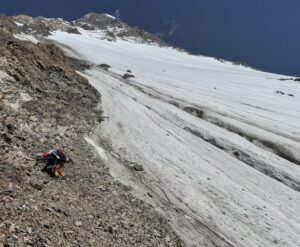The good weather settling in today or tomorrow coincides with the arrival of dozens or hundreds of climbers to the Baltoro area Base Camps.
However, after a long, stormy spell, it will take time for the mountains to shed their excess snow. Yet acceptable conditions may depend on how much in a hurry the individual climbers are. Some are willing to spare no expense to speed up their expeditions.

K2 wrapped in clouds, seen from Broad Peak Base Camp.
New regulations
A set of new regulations in Pakistan may lower the number of serial summiters. This season, international climbers cannot apply ahead of time for permits to several peaks. Instead, once they finish with one, they need to apply for the next and repeat the process for every mountain they want to climb.
Mingma G of Imagine Nepal also told ExplorersWeb that he is having some trouble with visas. Apparently, some members of his team entered Pakistan with a tourist visa but they apparently need a “mountaineering categorized visa” to climb in Pakistan. They have applied for new visas, but the process is taking long.
Why trek when you can fly?
Once again, the peak collectors will lead the way, and at least some of them will be well-rested, after flying to Base Camp. While helicopter taxis are normal in Nepal, they are rare in Pakistan. Here, the Pakistan army operates all the helicopters, which fly in pairs for safety reasons.
The Karakoram lies near the Chinese-Indian border and has a history of military tension. Helicopters were traditionally deployed only in case of emergency — mainly for rescues or to evacuate sick or injured climbers.
But very recently, some wealthy clients have agreed to pay $20,000 for a comfortable 40-minute trip to or from Base Camp. Viridiana Alvarez pointed out yesterday that helicopters also give a great view of the Baltoro Glacier from above:
Alvarez is part of a Seven Summit Treks group that also includes Kristin Harila and her sherpa team. Both Harila and Alvarez summited Nanga Parbat on June 26. They had plenty of time to return to Skardu and trek to the Gasherbrums, so saving time was no reason to fly. Nor was, apparently, saving money or reducing one’s carbon footprint. However, the Baltoro trek is demanding, the weather was bad, and the women had already acclimatized.
With the weather now expected to improve, they are rested and ready to move to Camp 1, where many climbers have already settled in. Like Base Camp, C1 is common to both Gasherbrums. It is not on the mountain itself but at 6,000m on the Gasherbrum Glacier.

Camp 1 on the Gasherbrums yesterday. Photo: Topo Mena
Above-average teams
This season features some of the highest numbers of commercial clients ever seen on the Gasherbrums (no figures available yet). But the Gasherbrums will also host the two most interesting 8,000m climbs of the summer: Denis Urubko and Pipi Cardell’s attempted new alpine-style route on GII and Andrzej Bargiel’s ski expedition on both peaks.
Urubko and Cardell have been waiting at the foot of the mountain for some time, while Bargiel reached Pakistan last week. After a first acclimatization trip up 6,400m Koshar Gang near Skardu, he and his team set off toward the Baltoro.
The Gasherbrums are also the next destination for the recent Nanga Parbat climbers. At least, for those who didn’t sustain frostbite during the exhausting summit push without a Camp 4.
None of them, as far as we know, are paying for an airlift. Some reported delays on their way to Skardu because of landslides on the Karakoram Highway. A big group including Saulius Damulevicius of Lithuania and others from Lela Peak Expedition reached Urdukas today, according to Damulevicius’ tracker.

Nanga Parbat climbers traveling by road on the Karakoram Highway. Photo: Saulius Damulevicius
Recently, the monsoon is becoming more active and affects larger areas of the country, sometimes precipitating catastrophic floods. This year, the Punjab is the most affected region.
Patience needed on K2
The more vigorous monsoon also seems to be responsible for the bad weather that has shut down the Karakoram lately. K2 teams started arriving in Base Camp two weeks ago but have been on hold since then. The relentless bad weather has barely allowed a first acclimatization round to Camp 1. Ropes have not been fixed beyond Camp 2.
EliteExped used the time to do some cleanup on the lower parts of the Abruzzi Spur route. The operation, led by Mingma David Sherpa, retrieved 200kg of trash, mainly old ropes, they reported.
Sajid Sadpara of Pakistan also announced a cleanup campaign of his own on K2. It will start soon, in cooperation with Seven Summit Treks. Sadpara’s team noted that Pakistan is one of the 10 countries most affected by climate change.

Sajid Sadpara announces his K2 cleanup campaign in Skardu. Photo: Sajid Sadpara/Instagram
Broad Peak
On Broad Peak, Furtenbach Adventures has started working well ahead of everyone else and launched a summit push last week. But the forecast on which they were relying proved wrong. Unexpected 100kph winds stopped them as soon as they reached the ridge. Out of time for further attempts, lead guide Ulises Corvalan called off the expedition.
The expedition sherpas and one guide then went to K2 to meet the K2 Flash team. This group has already acclimatized at home using the hypoxic tents provided by Furtenbach. Weather permitting, they are able to go to K2, climb it, and return home in three or four weeks total.
Other teams are trying to get some altitude despite the conditions. Horia Colibasanu of Romania has managed at least one rotation in snowy weather. Today, he took advantage of better weather to climb 1,400 vertical meters and pitch his small tent at Camp 2 (6,200m).

Horia Colibasanu at Camp 2 on Broad Peak today. Photo: Horia Colibasanu/Facebook






